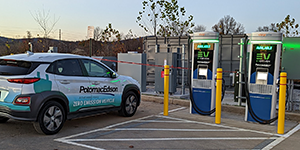EXPANDING ELECTRIC VEHICLE (EV) INFRASTRUCTURE
Transportation electrification has the potential to eliminate direct tailpipe emissions from gasoline-powered cars and improve air quality across our service area. Data from state departments of transportation and the Electric Power Research Institute (EPRI) indicates that there were over 150,000 registered EVs within FirstEnergy’s footprint, and the US Department of Energy reports over 1,300 active EV charging stations across our service territory. Significant federal incentives have been approved to help increase EV adoption, and our EV Driven programs in Maryland and New Jersey are making electric vehicle adoption more accessible, convenient and affordable. With the success of these programs, we are looking to expand EV programs and incentives to other states within our service territory.
The Infrastructure Investment and Jobs Act (IIJA) contains over $18 billion in funding for transportation electrification. One of the largest programs in the IIJA, the National Electric Vehicle Infrastructure (NEVI) formula grant program, is the $5 billion cornerstone of this funding with the goal of providing 500,000 EV fast charging stations along the nation’s travel corridors to help make cross-country EV travel accessible to all Americans. We have a team dedicated to helping potential NEVI grant recipients with their applications. One of these grant recipients is located in our Ohio Edison service territory in London, OH, and in December 2023 it became the very first EV charging site commissioned with NEVI funds to be energized in the U.S.

In Maryland, we’re supporting the state’s goal to have 300,000 zero-emission vehicles on the road by 2025 by installing utility-owned public charging stations throughout our Potomac Edison service area. Through year-end 2023, we have installed 61 charging stations, including 20 direct-current (DC) fast chargers, which can provide an 80% charge for most EVs in less than an hour. We have also installed Level 2 charging stations that accommodate two vehicles simultaneously and deliver 8 to 24 miles of range per hour of charging. In an extension filed with Maryland’s Public Service Commission (PSC) on March 1, 2024, we are looking to further improve access to EV charging by expanding our EV Driven programs.
In New Jersey, we’re supporting the state’s goal of deploying 330,000 light-duty electric vehicles by 2025 by providing incentives for electric vehicle charging infrastructure. With this four-year, $38.9 million program, JCP&L is providing incentives for residential, mixed-use commercial and multifamily property charging. We’re also working to increase public-access DC Fast charging, with incentives up to $25,000 per DC fast charger port for up to 248 charging locations accessible to the public across JCP&L’s service territory.
To learn more, visit our EV Driven website. The interactive website contains a wealth of information about electric cars, including a tool that allows you to view available car models and price ranges, calculate potential fuel cost savings, and understand the times associated with various charging options. You can also see if there are utility rates, rebates or tax incentives available at the federal or state levels.
